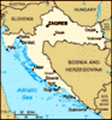Advertisement
Published: June 12th 2017
Geo: 45.3392, 14.3063
Something I have enjoyed about our tours with Gate1 is that they build in time to be flexible, and there are usually several optional tours for which you can sign up, or you can go and do something on your own. The first full day of tour was, in fact, optional, and involved visits to several towns on the Istrian Peninsula, of which Opatija is part. As nearly everyone had just arrived from the States, some elected to stay behind and rest, while others went off on their own -- some went to the lake region up in Slovenia, while another couple went scuba diving. We -- along with more than half of our group -- joined the tour, and we very glad we did.
Our first stop was in the town of Pula, on the tip of the peninsula. We were very surprised when our bus dropped us off along the waterfront, immediately across from where tenders from one of the new Viking Ocean Cruises ships were unloading. While Pula does have a large port -- and used to be the main anchorage for the Austro-Hungarian Empire -- I still did not expect to see a cruise ship,
albeit it a small one. Had this ship not been in port, I am certain we would have been the only tourists in town.
This was the first of many future stops during which we would be using our "whispers," which is a wireless earphone device we wore during tours. What a nice surprise and improvement. No pushing to get near to a guide in order to hear, and with the whisper, we could wander around and explore while the guide explained things. We made it over to the main sight in town ahead of the groups from the ship, which meant that we had the Roman Arena (read "mini Colosseum"😉 to ourselves. The structure dates back to ~50AD and is in remarkable condition, especially considering several major earthquakes over the proceeding two centuries. The tour was quite good, and included a visit underground, where we could see where gladiators waited and then were lifted up and into the center of the arena, through trapdoors in the ceiling. We also saw where various exotic animals (tigers, bears, etc.) were penned, and then also funneled up through the ceiling, so as to create maximum surprise and awe for the throngs watching the
gladiator matches.
The tour continued down into the walled historic city center, past several areas where we could clearly see the architectural impact of the time Pula spent as part of Venice, the Austro-Hungarian Empire, fascist Italy, and then communist Yugoslavia. Within the old town were two still-surviving Roman temples, though both of them were heavily damaged by allied bombing in World War II, but later rebuilt under Tito.
Our tour continued to the town of Rovinj, on the western side of the peninsula, and very close to the Italian border. The town, in fact, has a nearly equal split between Italian and Croatian speaking citizens, and is officially a bilingual city. The main historic old city is walled, and juts out into the Adriatic like a lollipop. The setting is idyllic. As the day before, however, there were temperature inversions, and the air was hazy until very late in the day, when things cooled off. Following a short whisper tour, we had time on our own to explore. The old town is built on a hill, so we winded our way up through postcard-like narrow alleys and streets, to which cars are prohibited. At the very top is the Basilica of
St. Euphemia, which dates to Venetian times, as clearly reflected in its similarity to St. Mark's in Venice. We discovered that for ~$2 each we could climb up the bell tower, where we were promised remarkable views. We were not disappointed in the views, but we were surprised at the 197 steps, which were all original wood beams, most of which were heavily worn and rickety. As such, you could see directly down through them, which led to a lot of vertigo. It was the only time I have seen Anna affected by height, and I wondered at times if she would make it to the top. We all soldiered on, and I'm sure K would admit to having her own trepidation as well, but it was worth it. From the top, we could finally see the entire town and I think it was a $6 well spent.
We made a few other stops along the winding route back to Opatija, most of which centered on seeing the regions primary commodities -- olives, wine, and lavender. In the end, we completed a full circle of the Istrian peninsula.
Dinner was on our own, and after consulting TripAdvisor we ended up at
a local restaurant near the base of the town. The place was unexpectedly hip. I was struck by how perfectly the waiters all spoke English, and this carried on throughout our entire trip. At every place we visited -- restaurant, bakery, hotel, etc. -- everyone spoke really strong English. An unexpected but nice surprise. The meal was excellent, and we got to sample our first Istrian wine. Though I didn't have my wine carrier with us on this trip, a few bottles of wine from throughout the trip did make their way home with us.
Advertisement
Tot: 0.058s; Tpl: 0.013s; cc: 7; qc: 24; dbt: 0.0359s; 1; m:domysql w:travelblog (10.17.0.13); sld: 1;
; mem: 1.1mb























